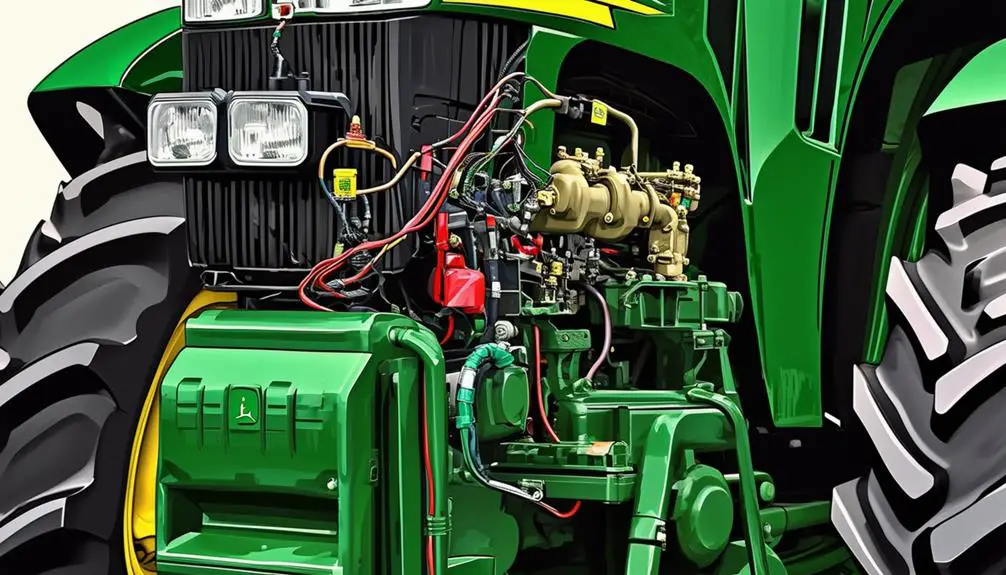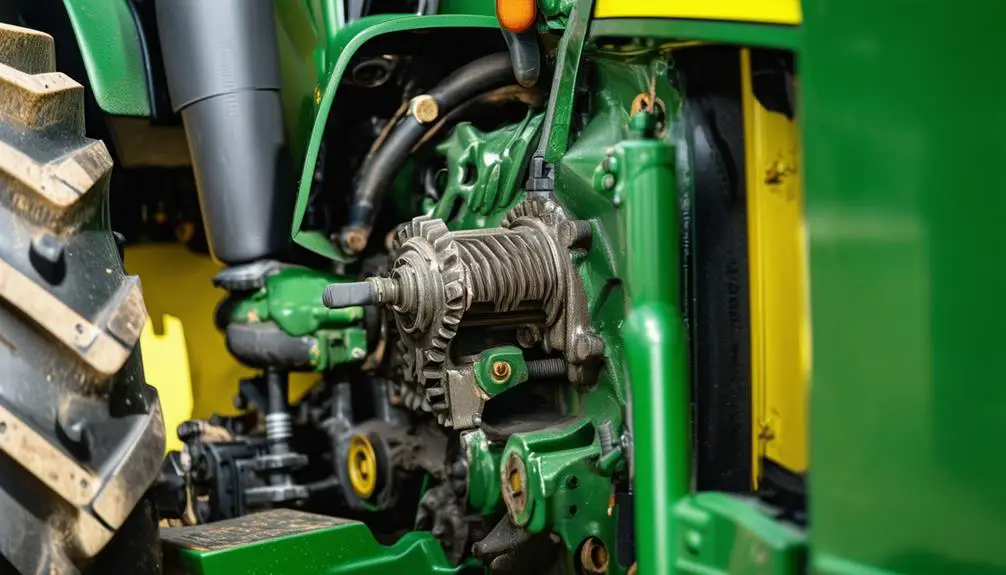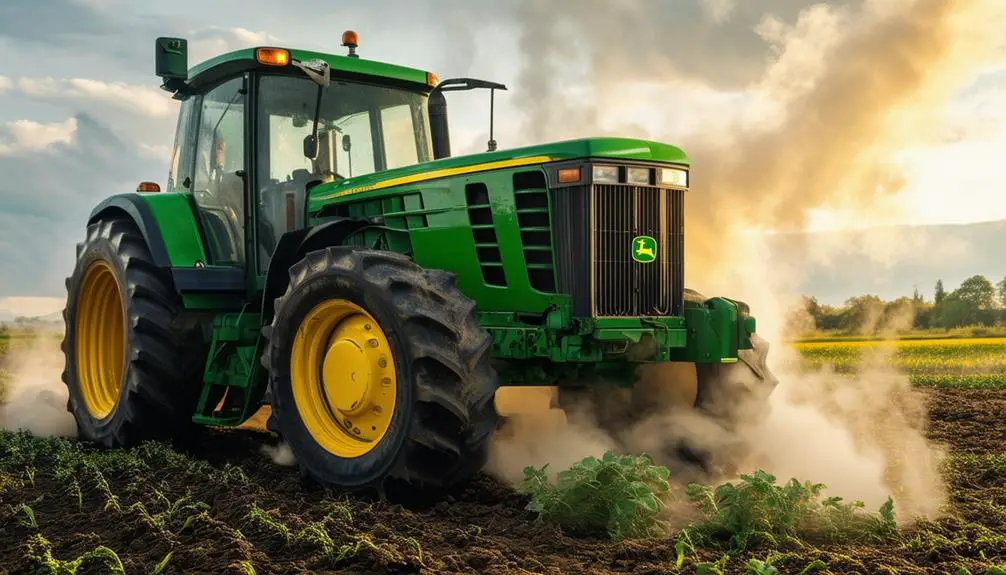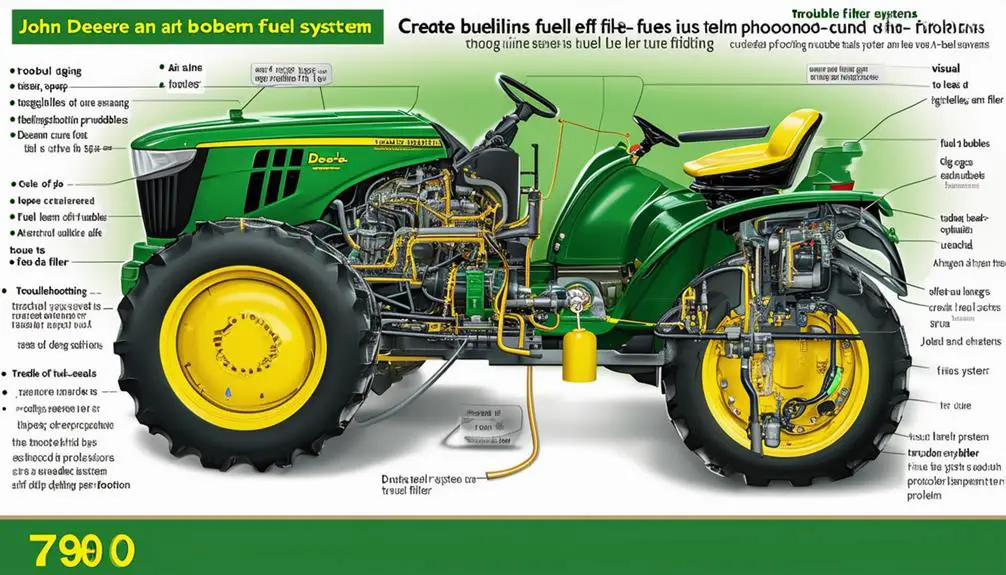If you've encountered some challenges with your John Deere 790, working through a troubleshooting guide could be beneficial. From subtle engine quirks to more complex hydraulic dilemmas, this guide offers a systematic approach to pinpointing and resolving common issues. By starting with the basics like engine starting problems and electrical system glitches, you'll be on the route to uncovering solutions that can keep your John Deere 790 running smoothly. So, what are some common pitfalls you should be aware of when it comes to troubleshooting your tractor?
Things to Note
- Check battery and connections for starting issues.
- Inspect transmission for malfunctions and leaks.
- Monitor hydraulic fluid levels and hoses for leaks.
- Address cooling system concerns promptly.
- Watch for steering, brake, and fuel system troubles.
Engine Starting Issues

If your John Deere 790 is experiencing engine starting issues, check the battery and connections first. Verify that the battery terminals are clean and tight, free from any corrosion that might impede the flow of power.
Freedom is at your fingertips when you take control of the situation. Don't let a simple battery issue hold you back from conquering your tasks with your trustworthy John Deere.
Take a few moments to inspect the battery for any signs of damage or wear. Sometimes a quick visual check can reveal underlying issues that are easily fixable.
Embrace the freedom that comes with being able to troubleshoot and solve problems on your own terms.
Once you've confirmed the battery and connections are in good shape, move on to other potential causes of the engine starting problems. Remember, you have the ability to diagnose and resolve issues with your John Deere 790, empowering you to get back to work with confidence and determination.
Electrical System Problems
Inspect your John Deere 790's electrical system for any signs of issues that may be impacting its performance. Start by checking the battery connections for corrosion or looseness. Tighten any loose connections and clean off any corrosion using a wire brush. Verify the battery is fully charged and holding a proper charge.
Next, examine the fuses for any signs of damage or blown fuses. Replace any faulty fuses with ones of the correct rating.
Check the wiring harness for any fraying, cuts, or exposed wires that could be causing a short circuit. Make sure all connections are secure and free of debris.
Test the voltage regulator and alternator for proper functioning to guarantee the battery is receiving the right amount of charge. If your lights are dim or flickering, it could indicate an issue with the alternator.
Transmission Troubleshooting

Examine the transmission of your John Deere 790 for any signs of malfunction or unusual behavior. If you notice rough shifting, grinding noises, slipping gears, or difficulty in engaging or disengaging gears, it could indicate a problem with the transmission.
Check the transmission fluid level and condition, verifying it's at the correct level and not contaminated. Inspect the transmission lines for any leaks or damage that may be impacting the system's performance.
If your John Deere 790's transmission is experiencing issues, it's important to address them promptly to prevent further damage and costly repairs. Consider consulting the owner's manual for guidance on regular maintenance tasks related to the transmission.
If you're unable to resolve the problem on your own, seeking assistance from a qualified mechanic or John Deere service center can help diagnose and fix the transmission issues effectively. By taking proactive steps to troubleshoot and address transmission problems, you can secure smooth operation and longevity of your John Deere 790.
Hydraulic System Malfunctions
If you're experiencing issues with your John Deere 790's hydraulic system, common offenders include low hydraulic fluid levels, leaking hoses, and potential pump failures.
These problems can lead to reduced performance and functionality of your equipment, impacting its overall efficiency.
It's essential to address these malfunctions promptly to avoid costly repairs and downtime.
Low Hydraulic Fluid
Check your John Deere 790 regularly for low hydraulic fluid to prevent possible hydraulic system malfunctions. Low hydraulic fluid can lead to issues like slow operation, loss of power, or even damage to the hydraulic components.
To guarantee smooth functioning, inspect the fluid levels frequently, especially before heavy use or demanding tasks.
If you notice that the hydraulic fluid is low, immediately top it up to the recommended level using the appropriate hydraulic fluid specified in the John Deere 790 manual. Remember, maintaining proper hydraulic fluid levels is essential for the overall performance and longevity of your equipment. Neglecting this simple task can result in costly repairs and downtime.
Regularly checking and maintaining the hydraulic fluid levels not only keeps your John Deere 790 running smoothly but also prevents unexpected breakdowns during important operations.
Leaking Hydraulic Hoses
Regularly examining your John Deere 790 for leaking hydraulic hoses is crucial to prevent potential hydraulic system malfunctions. Leaking hydraulic hoses can lead to a loss of hydraulic fluid, causing a drop in system pressure and inefficient operation of attachments.
To free yourself from the hassle of unexpected breakdowns, make it a habit to visually check the hoses for any signs of wear, cracks, or leaks. Look out for puddles of hydraulic fluid under the tractor or visible wet spots on the hoses themselves. Addressing these leaks promptly can save you time and money in the long run by preventing more significant issues within the hydraulic system.
If you notice any leaks, replace the faulty hoses immediately to maintain the proper functioning of your equipment. By staying proactive and attentive to the condition of your hydraulic hoses, you can ensure smooth operations and avoid costly repairs down the road.
Hydraulic Pump Failure
Keep a watchful eye for signs of hydraulic pump failure in your John Deere 790 to avoid potential hydraulic system malfunctions. When your hydraulic pump starts failing, you may notice a decrease in the overall performance of your equipment. If you experience slow or weak hydraulic functions, unusual noises like whining or grinding, or intermittent operation of attachments, these could be indicators of pump issues.
Addressing these signs promptly can prevent further damage to the hydraulic system and save you from costly repairs down the line.
Hydraulic pump failure can stem from various causes, including contamination, wear and tear, or lack of maintenance. Regularly checking and replacing hydraulic fluid, filters, and ensuring proper lubrication are essential steps in preventing pump failure. If you suspect pump issues, it's recommended to consult a professional mechanic to diagnose and repair the problem efficiently.
Cooling System Concerns

If you're experiencing cooling issues with your John Deere 790, understanding the causes of overheating is crucial. Inspecting the radiator for any signs of damage is another important step. Regularly checking the coolant level can help you maintain a healthy cooling system.
Keeping an eye on these key points can help you prevent potential overheating problems and guarantee your tractor operates smoothly.
Overheating Causes
Issues with the cooling system in your John Deere 790 tractor often lead to overheating problems. When your tractor overheats, it can be frustrating and may halt your work abruptly. One common cause of overheating is a low coolant level. Check the coolant reservoir to make sure it's filled to the proper level.
Another culprit could be a malfunctioning thermostat that isn't regulating the coolant flow effectively. Inspect the thermostat for any signs of wear or damage.
Additionally, a clogged radiator or a faulty water pump can impede the proper circulation of coolant, leading to overheating problems. Make sure to regularly clean the radiator and check the water pump for any leaks or malfunctions.
Ignoring these cooling system concerns can result in severe damage to your John Deere 790 tractor's engine. By addressing overheating causes promptly, you can prevent costly repairs and keep your tractor running smoothly.
Radiator Inspection Tips
Inspect the radiator for any signs of debris buildup or damage to guarantee peak cooling system performance. Keeping your radiator in top condition is essential for preventing overheating issues and ensuring your John Deere 790 runs smoothly.
Here are some tips to help you liberate your radiator from potential troubles:
- Clear Away Debris: Remove any dirt, leaves, or other debris blocking the radiator fins.
- Check for Corrosion: Look for any signs of rust or corrosion that could affect radiator function.
- Inspect for Leaks: Check for any visible leaks or puddles around the radiator area.
- Clean Regularly: Make it a habit to clean the radiator periodically to maintain ideal cooling efficiency.
- Ensure Proper Airflow: Confirm that there are no obstructions hindering the airflow through the radiator.
Coolant Level Check
To maximize performance of your John Deere 790, regularly check the coolant level in the cooling system. Proper coolant levels are essential for maintaining peak engine temperature and preventing overheating issues. Follow these simple steps to guarantee your coolant levels are where they should be:
| Coolant Level | Action Required |
|---|---|
| Below Minimum | Add coolant to the system |
| At Minimum | Monitor closely |
| Between Min & Max | Ideal level |
| At Max | No action needed |
| Above Max | Drain excess coolant |
Regularly inspecting the coolant level can help you catch any potential issues early on, preventing costly repairs and downtime. Remember to only check the coolant levels when the engine is cool to avoid injuries. By being proactive and keeping an eye on your coolant levels, you can optimize your John Deere 790 operates smoothly and efficiently.
Steering and Brake Problems
Addressing steering and brake concerns on your John Deere 790 is important for ensuring safe operation and best performance. Here are some tips to help you troubleshoot these issues:
- Check for leaking brake fluid: Don't let any leaks go unnoticed; they could compromise your safety.
- Inspect the steering wheel for unusual vibrations: Your comfort and control matter; don't ignore any strange movements.
- Test the brakes on different terrains: Your machine should respond consistently, no matter the surface.
- Look out for worn-out brake pads: Keeping them in good condition is key to efficient braking.
- Ensure proper wheel alignment: A small misalignment can lead to big problems down the road.
Fuel System Troubles

Guarantee your John Deere 790's fuel system is working properly to avoid potential issues during operation.
One common problem that can arise in the fuel system is clogging. This can happen due to dirty fuel filters or contaminated fuel. If you observe your tractor experiencing difficulty starting, sputtering, or losing power, it could indicate a blockage in the fuel system.
Another issue to watch out for is fuel leaks. Leaks can occur at various points in the fuel system, such as the fuel lines, connections, or the fuel tank itself. It's essential to address any leaks promptly to prevent fire hazards and ensure efficient operation of your tractor.
Additionally, be mindful of water contamination in the fuel, which can lead to corrosion and engine damage. Regularly inspecting and maintaining your fuel system will help keep your John Deere 790 running smoothly and efficiently.
Maintenance and Care Tips
Regular maintenance and proper care are essential for guaranteeing the longevity and best performance of your John Deere 790 tractor. To keep your machine running smoothly and efficiently, here are some maintenance and care tips to keep in mind:
- Schedule Regular Inspections: Check for any signs of wear and tear to address issues promptly.
- Keep It Clean: Regularly clean your tractor to prevent dirt and debris buildup that can affect performance.
- Monitor Fluid Levels: Ensure all fluids, such as oil, coolant, and hydraulic fluid, are at the recommended levels.
- Grease Moving Parts: Lubricate moving parts to reduce friction and prevent premature wear.
- Store Properly: When not in use, store your tractor in a dry and covered area to protect it from the elements.
Frequently Asked Questions
How Can I Improve the Fuel Efficiency of My John Deere 790?
To boost the fuel efficiency of your John Deere 790, start by ensuring proper maintenance. Regularly clean or replace air filters, check tire pressure, and use clean fuel.
Adjusting throttle settings and maintaining a steady speed can also help. Consider adding fuel additives for better performance.
Keep up with routine maintenance to keep your tractor running smoothly and efficiently.
Are There Any Common Issues With the PTO System on the John Deere 790?
Experiencing any hiccups with your John Deere 790's PTO system? It's not uncommon to run into a few snags here and there.
Keep an eye out for issues like clutch slippage, engagement troubles, or strange noises.
Don't stress, though. With a little investigation and some TLC, you'll have that PTO system purring like a contented kitten in no time.
Just a bump on the road to smoother operations!
What Are Some Ways to Prevent Rust and Corrosion on My Tractor?
To prevent rust and corrosion on your tractor, follow these key steps:
- Keep your tractor clean and dry after each use.
- Regularly inspect and touch up any paint chips or scratches to prevent moisture from seeping in.
- Apply a protective coating or wax to create a barrier against rust.
- Store your tractor in a covered area when not in use to shield it from the elements.
- Regular maintenance and care will keep your tractor looking and performing its best.
Can I Use Aftermarket Parts to Repair My John Deere 790?
Yes, you can use aftermarket parts to repair your John Deere 790. They can sometimes offer cost-effective solutions without compromising quality. Just make sure to research and choose reputable aftermarket suppliers to guarantee compatibility and durability.
It's your tractor, so feel empowered to explore different options that suit your needs and budget. Keep in mind that proper maintenance and installation are key to keeping your equipment running smoothly.
Are There Any Known Issues With the Seat Comfort on the John Deere 790?
So, let's talk about the seat comfort on your John Deere 790.
Ironically, you might expect a throne fit for a king, but some users find it a bit lacking in the comfort department.
If you're looking for a plush ride while mowing, you might want to contemplate adding some extra cushioning or support to make those long hours in the seat a bit cozier.
Conclusion
To sum up, by following this troubleshooting guide for common John Deere 790 problems, owners can effectively diagnose and resolve issues to guarantee their tractor operates smoothly.
Regular maintenance and care are essential to prevent future malfunctions and secure peak performance.
By addressing issues promptly and performing routine inspections, owners can prolong the lifespan of their John Deere 790 tractor and avoid costly repairs down the line.